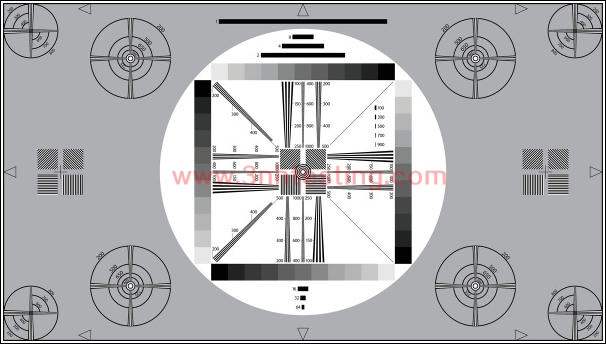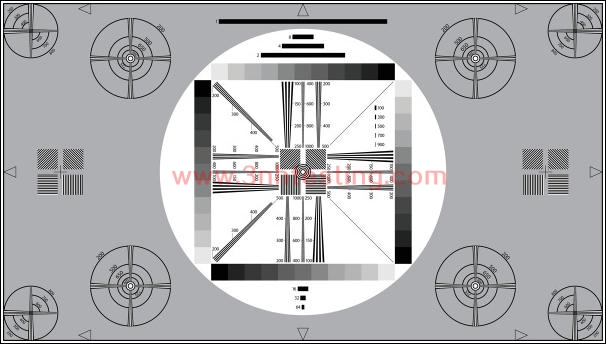HDTV UNIVERSAL TEST CHART
- Introduction
- Product Software
HDTV UNIVERSAL TEST CHART 16:9
REFLECTANCE

The TE117 is designed for quick (mainly visual) appraisal of transmission characteristics of
HDTV cameras.
In the center of the test chart on a gray background (D=0.75; reflectance = 18%) a white circle
with gray scales and resolution wedges is located. On both sides of this central circle four circles
with resolution wedges are arranged.
The 16:9 format is marked by four arrows located on the horizontal and vertical central lines. In
addition, four arrows located close to the circles on the upper and the bottom edge of the picture
mark the 4:3 format. Thus the test chart can also be used for testing 4:3 cameras.
The white central circles shows four gray scales each of 11 steps. They increase in equal linear
steps from D=0.15 to D=1.65 and are used for checking halftone rendition of HDTV cameras. Due
to the white surrounding area the results may, however, be qualified.
All frequency values in the test chart are indicated in cph (cycles per height). In the central circle
three resolution wedges with different frequencies are arranged vertically and horizontally. They
reach from 100 to 250, from 200 to 500 and from 400 to 1000 cph. In addition, two resolution
wedges angled in 45° generate frequencies of 200 to 500 cph.
In the middle of the test chart and on the left and right sides there are four squares with line rasters
that are inclined at angles of 0, 45, 90 and 135°. They generate a frequency of 200 cph. Those
line rasters which are inclined at angles of 45° and 135° generate a different frequency (141.4 cph)
in horizontal and vertical direction (due to their inclination). The eight outer circles are arranged in
such a way that they can be used both for 16:9 and 4:3 format. The larger ones show cross-shaped
resolution wedges. The circular rings, which can also be used for checking geometry, are designed f
or marking the resolution in vertical and horizontal direction. Resolution is shown at 200, 500, 660,
725 and 800 cph.
The outer circles in the four corners have longer resolution wedges. They cross at 500 cph and have
markings from 200 to 800 cph.
In the center of the test chart both in the gray and white area bar elements are arranged with a length
of 1 (=half the picture-height), 2, 4, 8, 16, 32 and 64 cph. Left to right vertical gray scale there are five
additional short bars with 100, 300, 500, 700 and 900 cph.
News
- 2014-06-26 3nh ROHS Certificate
- 2014-06-12 Color Fastness
- 2014-06-12 The Color of Objects
- 2017-06-27 Definition and formation of pixel n ...
- 2014-06-30 NS800 Spectrophotometer CE Certific ...
- 2014-06-12 Human Eyes to Distinguish Colors
- 2015-05-08 PANTONE CU Color Card (Electronic E ...
- 2017-07-08 How to use SFR resolution test char ...
.png)



.jpg)
.jpg)
.jpg)
.jpg)

